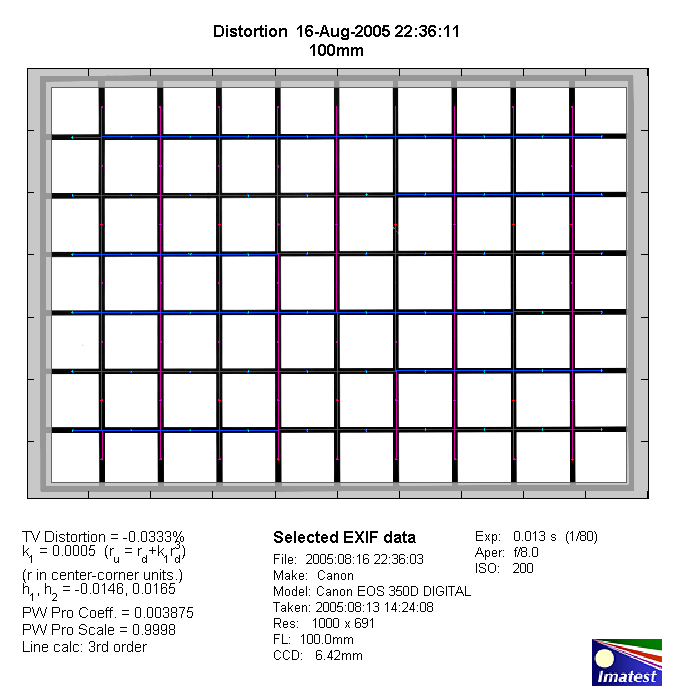|
Canon EF 100mm f/2.8 USM macro - (APS-C) Review / Test Report - Analysis |
|
Lens Reviews -
Canon EOS (APS-C)
|
|
Page 2 of 2

Distortion
Typical for prime lenses and especially for a macro lens the level of distortion is absolutely negligible.

Vignetting
The 100mm f/2.8 macro is a full format lens so it enjoys a sweet spot advantage when used on APS-C DSLRs. At f/2.8 it produces a medium degree of vignetting (~0.6EV) which is only visible in very critical scenes. The problem is basically irrelevant from f/4 onwards.

MTF (resolution)
The EF 100mm f/2.8 USM macro produced impressive MTF figures in the resolution lab.
The lens is already capable of delivering an excellent (just) center performance at f/2.8 followed by very good
borders/corners. The peak performance is reached between around f/5.6 with an excellent quality across the frame. The lens remains perfectly usable till about f/16. At f/22 diffraction effects have a rather drastic impact on the performance so this setting should be avoided on APS-C DSLRs - this is a physical limitation and not a design problem.
Please note that the MTF results are not directly comparable across the different systems!
Below is a simplified summary of the formal findings. The chart shows line widths per picture height (LW/PH) which can be taken as a measure for sharpness.
If you want to know more about the MTF50 figures you may check out the corresponding Imatest Explanations
Chromatic Aberrations (CAs)
Lateral chromatic aberrations (color shadows at harsh contrast transitions) are very low and really nothing to worry about in field conditions.

Bokeh
The bokeh (the quality of the out-of-focus blur) is a primary aspect for a macro lens and the Canon lens is a good performer here.
Out-of-focus highlights are very uniform and perfectly circular at f/2.8. The highlights deteriorate a little when stopping down -
upon closer observation you can spot some small traces of outlining at f/5.6. The critical focus transition zones are decently
rendered but not as as smooth as on the 100mm L lens for instance.

Bokeh Fringing / Longitudinal Chromatic Aberrations (LoCA)
Bokeh fringing is a problem which is present in most large aperture lenses but the EF 100mm f/2.8 performs better than most here.
At f/2.8 there's a bit of fringing visible but it's not overly significant - if you observe the provided sample crops (f/2.8) below you
may be able to spot traces of green (rear) & purple (front) halos in the focus transition zones. However, the problem is already very
hard to spot at f/4 and it's basically gone by f/5.6.
|
Move the mouse cursor over the f-stop marks below to observe the respective LoCAs
|
| f/2.8 |
f/4 |
f/5.6 |
|

|
VerdictThe Canon EF 100mm f/2.8 USM macro may be a comparatively old lens by now but it's still capable of playing
in the top league - easily. It provides sharp images straight from f/2.8 and it's downright excellent between
f/4 and f/8. Diffraction effects reduces the performance thereafter but it's fine to use all the way down to
f/16. Neither distortions nor lateral CAs are something to worry about. Thanks to its full format design it
produces only a medium degree of vignetting at f/2.8 when used on APS-C DSLRs. The amount of LoCAs (bokeh fringing)
is comparatively moderate even at f/2.8. The quality of the bokeh (out-of-focus blur) is pretty good although
not perfect.
The Canon lens features a true IF (internal focusing) mechanism so its physical length remains constant
regardless of the focus setting - in terms of long term durability this is clearly a superior approach
compared to the usual extension system used in third party lenses. The principal build quality leaves
also nothing to be desired for a lens in this class. The implementation of the USM (ultrasonic AF) is
excellent - compared to conventional macro lenses in this range it is a speed daemon here and a near silent
one.
All-in-all highly recommended for APS-C EOS DSLRs!
|